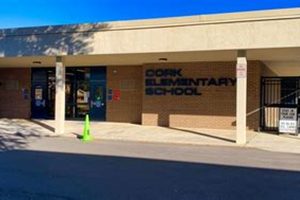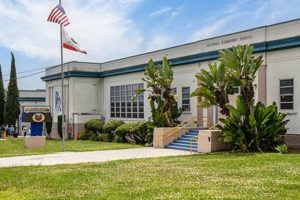An elementary school provides foundational education for young children, typically from kindergarten through fifth or sixth grade. This type of institution focuses on core subjects such as reading, writing, mathematics, science, and social studies, establishing a base for future academic pursuits. It often serves as a central community hub, fostering social-emotional learning and providing resources for families.
Early childhood education plays a vital role in individual development and societal progress. It equips students with essential literacy and numeracy skills, cultivates critical thinking and problem-solving abilities, and promotes social responsibility. The history of elementary education reflects evolving pedagogical philosophies and societal needs, continually adapting to provide optimal learning environments.
This article will further explore specific aspects of this vital educational institution, delving into topics such as curriculum development, community engagement, and the evolving role of technology in shaping the future of learning.
Tips for a Successful Elementary School Experience
A positive and productive elementary school experience lays the groundwork for future academic success and personal growth. The following tips offer guidance for families and educators to contribute to a thriving learning environment.
Tip 1: Foster a Love of Reading: Regular reading at home significantly contributes to literacy development. Establish a dedicated reading time each day and explore diverse genres to spark curiosity.
Tip 2: Encourage Curiosity and Exploration: Cultivate a sense of wonder by engaging children in hands-on activities, exploring nature, and visiting museums or libraries. Asking open-ended questions stimulates critical thinking.
Tip 3: Prioritize Open Communication: Maintain consistent communication with teachers and school staff. Regularly discuss academic progress, social interactions, and any concerns that may arise.
Tip 4: Establish Consistent Routines: Consistent routines, including designated study time and regular bedtimes, provide structure and support academic performance.
Tip 5: Encourage Active Participation: Encourage involvement in extracurricular activities, school events, and community projects to foster a sense of belonging and develop social skills.
Tip 6: Promote Healthy Habits: Nutritious meals, regular exercise, and adequate sleep are crucial for physical and cognitive development, directly impacting academic success.
Tip 7: Celebrate Achievements: Acknowledging both small and large accomplishments builds confidence and motivates continued effort. Positive reinforcement encourages a growth mindset.
By implementing these strategies, families and educators can create a supportive environment that nurtures academic growth, social-emotional development, and a lifelong love of learning.
This foundation established during the elementary school years serves as a springboard for future success, equipping individuals with the skills and mindset necessary to thrive.
1. Early Childhood Education
Early childhood education forms the cornerstone of a successful elementary school experience, providing the foundational skills and knowledge necessary for future academic achievement. This period, typically encompassing pre-kindergarten through third grade, represents a critical window for cognitive, social, and emotional development. Within the context of an elementary school like Clarke Elementary School, early childhood education sets the stage for a lifelong love of learning. Effective early childhood programs emphasize play-based learning, fostering creativity, problem-solving skills, and social-emotional intelligence. For example, a kindergarten class engaging in a collaborative building project not only develops fine motor skills but also encourages teamwork and communication. These early experiences shape a child’s approach to learning and contribute to their overall academic trajectory.
The importance of early childhood education as a component of Clarke Elementary School’s success cannot be overstated. Research consistently demonstrates the long-term benefits of high-quality early learning experiences, including improved literacy and numeracy skills, increased high school graduation rates, and reduced rates of incarceration. Investing in robust early childhood programs within the elementary school setting creates a strong foundation for future academic success and contributes to a more equitable educational landscape. Practical applications of this understanding include allocating appropriate resources to early childhood classrooms, providing ongoing professional development for early childhood educators, and engaging families in the learning process. For instance, implementing a parent-teacher reading program can strengthen the home-school connection and support early literacy development.
In conclusion, early childhood education serves as a crucial building block within the elementary school system. By prioritizing high-quality early learning experiences, Clarke Elementary School can equip its students with the essential skills and knowledge needed to thrive academically and personally. Addressing challenges such as ensuring equitable access to early childhood education and providing adequate support for early childhood educators remains vital for maximizing the impact of these formative years. A strong emphasis on early childhood education is not merely a component of a successful elementary school; it is an investment in the future of each child and the community as a whole.
2. Curriculum Development
Curriculum development is integral to the educational experience at Clarke Elementary School, directly impacting student learning outcomes. A well-designed curriculum provides a structured framework for instruction, ensuring alignment with educational standards and best practices. This framework guides educators in delivering engaging and effective lessons, fostering a positive learning environment. Cause and effect relationships are central to curriculum development. For example, a curriculum emphasizing inquiry-based learning can lead to increased student engagement and deeper understanding of concepts. Conversely, a fragmented or poorly designed curriculum can hinder student progress and create learning gaps. The importance of curriculum development as a component of Clarke Elementary School’s success lies in its ability to create a cohesive and purposeful learning journey for students.
Real-life examples illustrate the practical significance of a thoughtfully developed curriculum. A mathematics curriculum incorporating hands-on activities and real-world problem-solving can foster a deeper understanding of mathematical concepts. Similarly, a language arts curriculum rich in diverse literature can cultivate critical thinking skills and expand students’ cultural awareness. The integration of technology into the curriculum can further enhance learning by providing interactive and engaging educational experiences. For instance, using educational software to reinforce literacy skills or virtual field trips to explore historical sites can enrich and extend classroom learning. Analyzing the impact of curriculum design choices on student achievement is crucial for continuous improvement. Data-driven decision-making, informed by student performance and feedback, allows educators to refine curriculum content and instructional strategies to better meet student needs.
In conclusion, curriculum development is not a static process but rather a dynamic and ongoing cycle of planning, implementation, assessment, and refinement. At Clarke Elementary School, a commitment to robust curriculum development ensures that students receive a high-quality education that prepares them for future success. Addressing challenges such as aligning curriculum with evolving educational standards and incorporating innovative teaching practices requires ongoing professional development for educators and a collaborative approach to curriculum design. Ultimately, a well-designed curriculum empowers students with the knowledge, skills, and critical thinking abilities necessary to thrive in a complex and ever-changing world.
3. Community Engagement
Community engagement serves as a vital link between Clarke Elementary School and the families and individuals it serves. Strong community partnerships create a supportive ecosystem that enriches the educational experience and fosters a sense of belonging. Cause and effect relationships are evident in the impact of community engagement. For instance, active parental involvement correlates with improved student attendance and academic performance. Similarly, partnerships with local organizations can provide valuable resources and learning opportunities, expanding the scope of the school’s educational offerings. The importance of community engagement as a component of Clarke Elementary School’s success lies in its ability to create a shared responsibility for student well-being and academic achievement.
Real-life examples demonstrate the practical significance of community engagement. Volunteer programs, where community members assist in classrooms or mentor students, can provide individualized support and foster positive relationships. School-sponsored events, such as family literacy nights or science fairs, create opportunities for families to actively participate in the learning process. Collaborations with local businesses or community organizations can bring real-world expertise into the classroom, enriching curriculum content and providing career exploration opportunities. For example, a partnership with a local museum could provide students with hands-on learning experiences related to history or science. Furthermore, community engagement can play a critical role in advocating for school resources and policy changes that benefit students and families.
In conclusion, community engagement is not merely an ancillary activity but an integral component of a thriving elementary school. At Clarke Elementary School, fostering strong community partnerships strengthens the educational fabric and creates a more inclusive and supportive learning environment. Addressing challenges such as overcoming barriers to participation and ensuring equitable access to resources requires ongoing communication and collaboration between the school and the community it serves. Ultimately, a vibrant and engaged community empowers Clarke Elementary School to fulfill its mission of providing a high-quality education for all students.
4. Teacher Development
Teacher development is essential for Clarke Elementary School’s success, directly impacting the quality of education students receive. Investing in ongoing professional growth for educators ensures they possess the knowledge, skills, and pedagogical approaches necessary to meet the evolving needs of young learners. This commitment to teacher development fosters a dynamic learning environment characterized by innovation, collaboration, and a dedication to continuous improvement.
- Effective Instructional Strategies
Effective instructional strategies are crucial for creating engaging and impactful learning experiences. Teachers proficient in differentiated instruction, inquiry-based learning, and technology integration can tailor their teaching to meet diverse learning styles and abilities. For example, a teacher utilizing project-based learning in a science class allows students to explore concepts through hands-on experimentation and collaboration. This approach fosters deeper understanding and critical thinking skills. At Clarke Elementary School, ongoing professional development in these areas equips teachers with the tools they need to create a stimulating and effective learning environment.
- Classroom Management Techniques
Effective classroom management is essential for creating a positive and productive learning environment. Teachers skilled in establishing clear expectations, building positive relationships with students, and addressing behavioral challenges can foster a classroom culture of respect and cooperation. For instance, a teacher implementing restorative justice practices creates opportunities for students to resolve conflicts peacefully and take responsibility for their actions. At Clarke Elementary School, professional development in classroom management techniques empowers teachers to create a safe and supportive learning space where all students can thrive.
- Assessment and Data Analysis
Data-driven decision-making is fundamental to improving educational outcomes. Teachers skilled in using formative and summative assessments, analyzing student data, and using that data to inform instructional practices can personalize learning and address individual student needs. For example, a teacher regularly reviewing student performance data can identify areas of strength and weakness, allowing for targeted interventions and differentiated instruction. At Clarke Elementary School, professional development in assessment and data analysis equips teachers with the skills to monitor student progress effectively and make data-informed instructional adjustments.
- Collaboration and Professional Learning Communities
Collaboration and participation in professional learning communities (PLCs) are essential for fostering a culture of continuous improvement within a school. Teachers who regularly collaborate with colleagues, share best practices, and engage in reflective discussions can collectively enhance their teaching skills and refine instructional strategies. For instance, teachers participating in a PLC focused on literacy instruction might share successful reading intervention strategies or collaborate on developing engaging literacy activities. At Clarke Elementary School, fostering a collaborative environment and supporting PLC participation contributes to a shared commitment to professional growth and improved student outcomes.
These interconnected facets of teacher development contribute significantly to Clarke Elementary School’s overall success. By investing in the professional growth of its educators, the school fosters a culture of continuous improvement, ensuring that students receive a high-quality education that prepares them for future challenges and opportunities. Continual teacher development is not merely a beneficial practice; it is an essential investment in the future of Clarke Elementary School and the students it serves.
5. Resource Allocation
Resource allocation significantly influences the educational landscape at Clarke Elementary School. Effective allocation of resourcesincluding funding, personnel, materials, and technologydirectly impacts the quality of education provided and the overall learning environment. Strategic resource allocation ensures that essential programs and services are adequately supported, enabling the school to meet the diverse needs of its students and achieve its educational goals. Examining resource allocation within Clarke Elementary School provides insights into the institution’s priorities and its commitment to providing equitable and effective educational opportunities.
- Budgetary Decisions and Funding Priorities
Budgetary decisions reflect the values and priorities of Clarke Elementary School. Allocating funds to specific programs, such as early childhood education, special education, or arts enrichment, demonstrates the school’s commitment to those areas. For example, prioritizing funding for classroom technology might indicate a focus on integrating digital learning tools into the curriculum. Analyzing budgetary decisions provides insights into how resources are strategically allocated to support different aspects of the educational program.
- Staffing and Personnel Resources
The allocation of staffing resources, including teachers, support staff, and administrators, directly impacts the student-teacher ratio and the availability of specialized services. For instance, allocating additional resources to hire reading specialists or counselors can provide targeted support for students requiring individualized attention. Examining staffing patterns reveals how human resources are deployed to meet student needs and support the school’s educational mission.
- Learning Materials and Educational Technology
The provision of learning materials and educational technology plays a crucial role in creating engaging and effective learning experiences. Allocating resources to purchase updated textbooks, science equipment, or digital learning platforms can enhance classroom instruction and provide students with access to contemporary learning tools. For example, providing each student with a tablet computer could facilitate personalized learning and access to online educational resources.
- Facilities and Infrastructure
Maintaining and upgrading school facilities and infrastructure are essential for creating a safe and conducive learning environment. Allocating resources to improve classroom spaces, libraries, or outdoor play areas demonstrates a commitment to providing students with a comfortable and stimulating learning environment. For instance, renovating a school library to create a modern learning commons with collaborative workspaces and digital resources can enhance student learning and engagement. The allocation of resources to maintain facilities reflects the school’s dedication to providing a positive and productive learning environment for its students.
The strategic allocation of these various resources shapes the educational experience at Clarke Elementary School. Analyzing resource allocation provides valuable insights into the school’s priorities and its commitment to providing a well-rounded and effective education for all students. Understanding how resources are distributed allows for informed discussions about the school’s effectiveness and its capacity to meet the diverse needs of its student population.
6. Student Well-being
Student well-being forms the foundation of a successful learning experience at Clarke Elementary School. A supportive and nurturing environment, where students feel safe, respected, and valued, directly impacts their academic performance, social-emotional development, and overall life trajectory. Cause and effect relationships are evident: a positive school climate fosters increased student engagement and improved academic outcomes, while a stressful or unsupportive environment can hinder learning and contribute to negative social-emotional outcomes. The importance of student well-being as a component of Clarke Elementary School’s success lies in its recognition that academic achievement thrives when students’ physical, emotional, and social needs are met.
Real-life examples illustrate this connection. Implementing anti-bullying programs fosters a more inclusive and respectful school climate, leading to decreased incidents of bullying and increased student feelings of safety. Providing access to mental health services supports students experiencing emotional or behavioral challenges, enabling them to better manage their well-being and engage more effectively in learning. Establishing school-wide expectations for positive behavior and implementing restorative justice practices creates a culture of accountability and respect, contributing to a more positive school environment. Furthermore, initiatives promoting healthy lifestyles, such as nutrition education and physical activity programs, contribute to students’ physical well-being, which is intrinsically linked to their overall academic and emotional health. For instance, offering nutritious meals and encouraging physical activity during the school day can improve students’ concentration and focus in the classroom.
In conclusion, student well-being is not merely a desirable outcome but an essential component of Clarke Elementary School’s educational mission. Prioritizing student well-being creates a learning environment where students can thrive academically, socially, and emotionally. Addressing challenges, such as ensuring equitable access to mental health services and fostering a culture of inclusivity, requires ongoing commitment and collaboration among school staff, families, and the broader community. Ultimately, a focus on student well-being is an investment in the future, equipping students with the resilience, social-emotional skills, and overall well-being necessary to succeed in school and beyond.
Frequently Asked Questions
This section addresses common inquiries regarding elementary education, providing concise and informative responses.
Question 1: What is the typical age range for students attending elementary school?
Elementary schools typically serve students aged five through eleven, encompassing kindergarten through fifth or sixth grade, depending on local educational structures.
Question 2: What core subjects are taught at the elementary level?
Core subjects include language arts (reading, writing, grammar), mathematics, science, social studies, and the arts. Physical education and health are also integral components of the curriculum.
Question 3: How can parents support their child’s academic success in elementary school?
Parental involvement plays a crucial role. Regular communication with teachers, establishing consistent routines for homework and study, and creating a supportive learning environment at home contribute significantly to student success. Active participation in school events and parent-teacher organizations further strengthens the home-school connection.
Question 4: What is the role of standardized testing in elementary education?
Standardized tests provide a snapshot of student performance and assess academic progress relative to established benchmarks. These assessments inform instructional practices and identify areas where students may require additional support. Results also contribute to school-wide improvement efforts and curriculum development.
Question 5: How does elementary school prepare students for future academic endeavors?
Elementary school establishes the foundational skills necessary for success in higher grades. It cultivates critical thinking, problem-solving, and communication skills, fostering a lifelong love of learning and preparing students for the academic rigors of middle and high school.
Question 6: What resources are available to support students with learning differences or special needs?
Elementary schools provide specialized services and support for students with learning differences or special needs. Individualized Education Programs (IEPs) are developed to address specific learning needs, ensuring that all students have access to an appropriate education. Resource rooms, specialized instruction, and support staff provide tailored assistance, fostering inclusive learning environments.
Understanding these fundamental aspects of elementary education provides a framework for effective partnerships between families, educators, and the community, ensuring a positive and productive learning experience for all students.
The following section will delve into specific programs and initiatives offered at Clarke Elementary School.
Conclusion
This exploration of Clarke Elementary School has highlighted the multifaceted nature of a successful elementary education. From the foundational importance of early childhood development to the ongoing commitment to teacher development and community engagement, each component contributes to a thriving learning environment. Resource allocation strategies and a focus on student well-being further underscore the institution’s dedication to providing a high-quality education that equips students with the skills and knowledge necessary to thrive.
The future of Clarke Elementary School rests upon continued dedication to these core principles. By fostering strong partnerships among educators, families, and the community, the institution can ensure that every student receives the support and opportunities they need to reach their full potential. Investing in elementary education is an investment in the future, shaping individuals who will contribute meaningfully to society.







